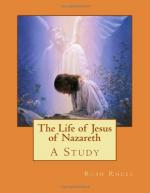46. The country of the Gerasenes, Gadarenes, or Gergesenes. Gadarenes is the best attested reading in Mt. viii. 28, Gerasenes in Mk. v. 1 and Lk. viii. 26; Gergesenes has only secondary attestation. Gadara is identified with Um Keis on the Yarmuk, some six miles SE of the Sea of Galilee. This cannot have been the site of the miracle, though it is possible that Gadara may have controlled the country round about, including the shores of the sea. Gerasa is the name of a city in the highlands of Gilead, twenty miles E of Jordan, and thirty-five SE of the Sea of Galilee, and it clearly cannot have been the scene of the miracle. Near the E shore of the sea Thomson discovered the ruins of a village which now bears the name Khersa. The formation of the land in the neighborhood closely suits the narrative of the gospels. This is now accepted as the true identification. See Thomson Land and Book, Central Palestine, 353-355; SBD^2 1097-1100; HastBD II. 159f.; AndLOL 296-300. The name “Gadarenes” may indicate that Gadara had jurisdiction over the region of Khersa; the names “Gerasenes” and “Gergesenes” may be derived directly and independently from Khersa, or may be corruptions due to the obscurity of Khersa.
47. The feeding of the five thousand took place on the E of the sea, in a desert region, abundant in grass, and mountainous, and located in the neighborhood of a place named Bethsaida. Near the ruins of Bethsaida Julias is a plain called now Butaiha, “a smooth, grassy place near the sea and the mountains,” which meets the requirements of the narrative. See AndLOL 322f.
48. The return of Jesus from the regions of Tyre “through Sidon" (Mk. vii. 31) avoided Galilee, crossing N of Galilee to the territory of Philip and “the Decapolis.” This latter name applies to a group of free Greek cities, situated for the most part E of the Jordan. Most of the cities of the group were farther S than the Sea of Galilee; some, however, were E and NE of that sea, hence Jesus’ approach from Caesarea Philippi or Damascus could be described as “through Decapolis.” See SmithHGHL 593-608; En Bib I. 1051 ff.; SchuererJPTX II. i. 94-121.
49. Of Magadan (Mt. xv. 39) or Dalmanutha (Mk. viii. 10) all that is known is that they must have been on the W coast of the Sea of Galilee. They have never been identified, though there are many conjectures. See SBD^2, HastBD, and En Bib.
50. Caesarea Philippi was situated at the easternmost and most important of the sources of the Jordan, it is called Panias by Jos. Ant. xv. 10.3, now Banias. Probably a sanctuary of the god Pan. Here Herod the Great built a temple which he dedicated to Caesar; Philip the Tetrarch enlarged the town and called it Caesarea Philippi. See SBD^2; HastBD; EnBib.




